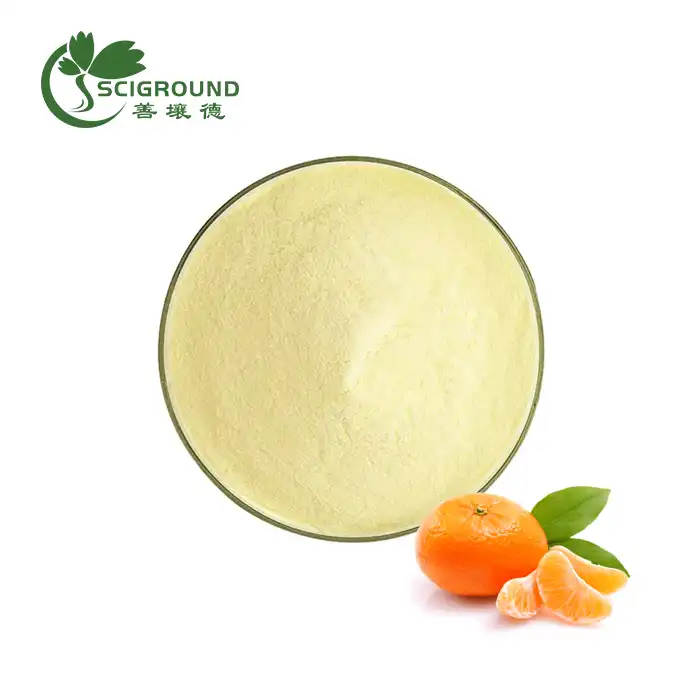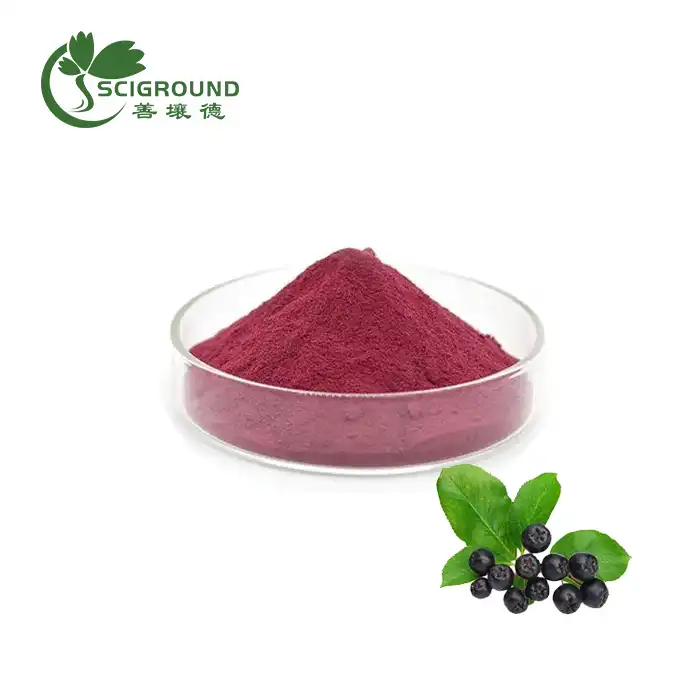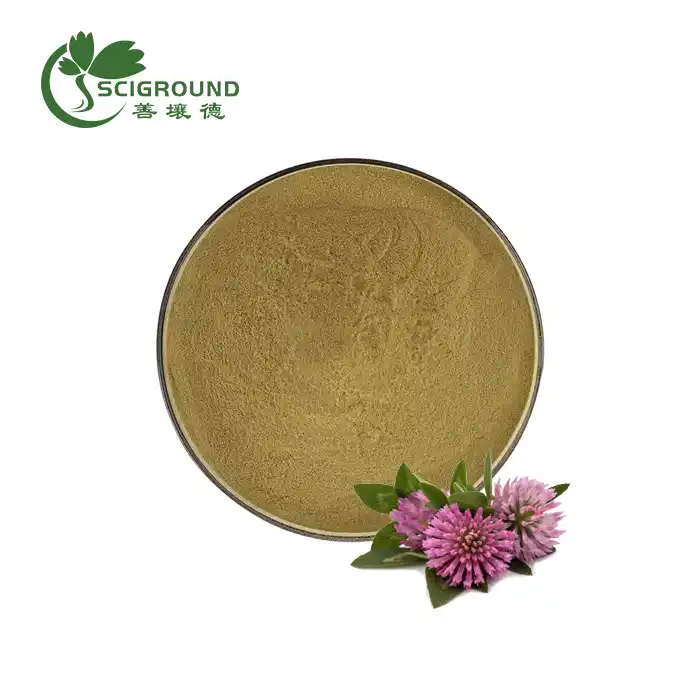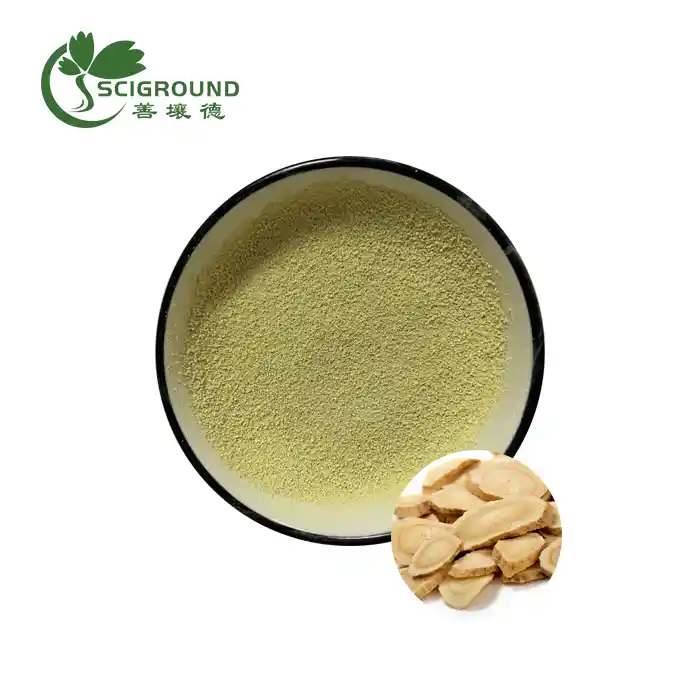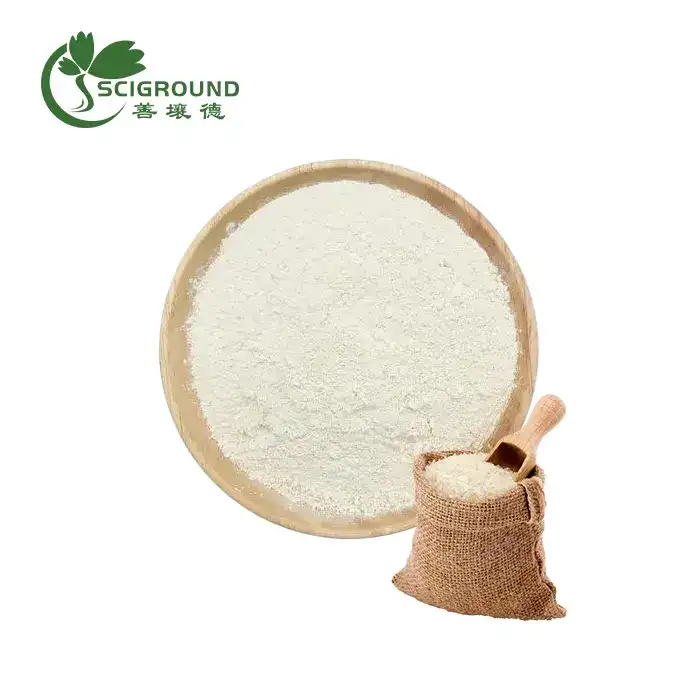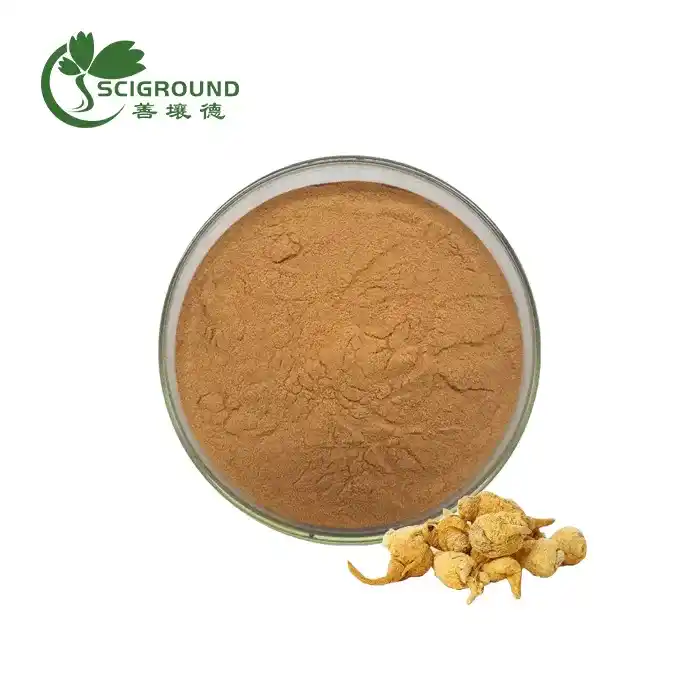How to Extract Inulin
Inulin is a type of carbohydrate known as a fructan that is found naturally in many plants. It can be extracted from various sources, most commonly chicory root. Inulin has become popular in recent years due to its potential health benefits and uses as a prebiotic fiber. This article will explain how to extract inulin from chicory root and other sources, how to incorporate it into your diet, the extraction process, and how inulin powder is made commercially.
What is Inulin?
Inulin is a soluble dietary fiber and fructan made up of fructose molecules chained together with a glucose molecule at the end. The chain length of inulin can vary, with molecules containing between 2 to 60 fructose units. Inulin is considered a prebiotic as it provides nourishment for beneficial bacteria in the intestines. It is also classified as a non-digestible oligosaccharide since the human digestive system cannot fully break it down.
Inulin occurs naturally in over 36,000 plants, including chicory, Jerusalem artichokes, garlic, onions, bananas, and asparagus. It is extracted commercially most often from chicory roots where it makes up 40-70% of the carbohydrates. Inulin from chicory root contains longer chain lengths with over 20 fructose units while inulin from other sources is shorter.

How to Extract Inulin from chicory root?
Chicory root inuin is one of the best natural sources of inulin available, which is why it is primarily used for commercial inulin extraction. Compared to other plants, chicory roots contain very high amounts of inulin at levels of 15-20% of the root’s total dry weight. The longer chain inulins found in chicory have excellent prebiotic activity and technological benefits.
Chicory is also fast growing, inexpensive, and simple to cultivate. The root is drought and cold resistant. Chicory contains low levels of lignin and pectin, which makes inulin extraction more efficient compared to other sources. For these reasons, chicory root is the preferred industrial source for extracting natural inulin.
Chicory root can be extracted using hot water to remove the inulin, oils, and other components from the plant material. Here are two common extraction methods:
Hot Water Extraction
Chop or grind dried chicory roots into small pieces.
Add chicory and hot water to extractor tank in a 1:10 ratio. Water should be 70-90°C.
Agitate or stir the mixture for 1-2 hours as the hot water diffuses into the root pieces and dissolves out contents.
Drain off the water which now contains the inulin, oils, and other extracts.
Filter the extracts through a mesh screen to remove particulates.
Countercurrent Extraction
Fill a tall percolation column with fresh chicory root pieces.
Pump hot water (70-80°C) in at the top and allow it to filter slowly down through the column.
Re-circulate the extracted liquid from the bottom back to the top for continuous diffusion.
The concentrate will build up inulin and oils from the fresh root material.
Drain off the concentrated liquid extract once fully percolated.
The extraction yield can be improved by doing multiple rounds of hot water extraction or using a countercurrent percolation system. This removes more of the available inulin and plant chemicals from the chicory root.
On an industrial scale, bulk inulin is extracted from chicory roots most efficiently through hot water diffusion and percolation. The basic industrial extraction process is:
Chicory roots are cleaned, sliced, and shredded to open the cell structure.
The chicory root pieces are then diffused with hot water heated to 70-90°C in a large extraction tank. The hot water dissolves and draws out the inulin from the plant cells.
After 1-2 hours, the spent roots are removed and fresh roots are added to repeat the diffusion process up to 3 times.
The inulin-rich water passes through a percolation column filled with fresh chicory for countercurrent extraction.
The extracted inulin liquid is then filtered, concentrated through evaporation, and precipitated with ethanol to isolate pure inulin powder.
This hot water diffusion and percolation method efficiently extracts over 95% of the available inulin from chicory roots. It produces high purity inulin while avoiding degradation from excess heat.
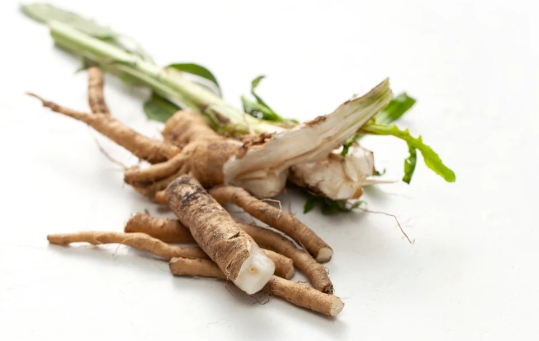
Health Benefits of Inulin
Prebiotic effects - Inulin feeds beneficial bifidobacteria in the colon, enhancing gastrointestinal health.
Calcium absorption - Research indicates inulin improves the absorption of calcium and magnesium in the body.
Weight loss aid - By improving gut bacteria, inulin may help reduce weight gain and fat accumulation.
Blood sugar regulation - Inulin has shown potential to reduce spikes in blood glucose and insulin levels after eating.
Heart health - Soluble fiber like inulin can reduce LDL cholesterol levels and lower risk of heart disease.
Cancer prevention - Inulin may inhibit colon cancer cell growth by enhancing defenses against carcinogens.
Bone health - The increased calcium absorption provided by inulin can help strengthen bones and prevent osteoporosis.
How to Get Inulin in Your Diet?
There are two main ways to add inulin to your diet - through food sources or as a supplement. Good food sources of inulin include:
Chicory root - can be baked, roasted, boiled, or steeped for tea.
Jerusalem artichoke - eat tubers raw or cooked like potatoes.
Onions - high levels in white and yellow onions.
Garlic - contains modest amounts of inulin.
Asparagus - significant inulin in young shoots and stems.
Bananas - unripe bananas have resistant starch that acts as inulin.
Wheat - small amounts found in whole grains.
Many companies also sell inulin as a supplement, usually in powder form. Inulin powder can simply be added to foods, drinks, smoothies, or baked goods. Start with 1-2 teaspoons daily and gradually increase up to 5-10 grams per day.
How to Extract Inulin at Home?
It is possible to extract crude bulk inulin powder at home from chicory roots or other sources. Here is a simple process:
Obtain fresh chicory roots or other plant material high in inulin.
Wash, peel and chop the roots into small pieces.
Add the chopped roots to a pot of water, using 3-4 cups of water per 1 cup of chopped roots.
Bring the roots and water to a boil, then reduce heat and simmer for 15-20 minutes.
Strain out the plant material, reserving the liquid which now contains extracted inulin.
Allow the liquid to cool completely so the inulin precipitates out.
Pour off the remaining water and collect the crude inulin paste from the bottom.
Dry the inulin paste further into a powder using low heat in the oven or sun.
This will produce a crude extract containing 50-70% inulin. For higher purity professional extraction is needed. Home extracted inulin can be added to foods or taken as a supplement.
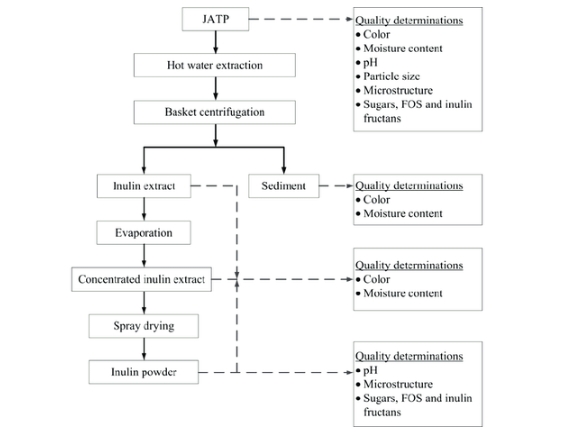
image from www.researchgate.net
Commercial Inulin Extraction Process
Inulin is extracted from chicory roots on an industrial scale through a multi-step process optimized for efficiency and high purity. Here are the basics steps:
Washing and Diffusion
Chicory roots are cleaned, mechanically sliced, then washed with hot water at 70-80°C to remove sugars and impurities. The roots undergo a diffusing process with hot water circulating over them to dissolve and extract the inulin powder.
Refining and Filtration
The extracted inulin liquid is treated with proteins that precipitate out impurities. It then goes through pressure filtration to remove remaining particles and concentrated.
Precipitation and Drying
Ethanol is added to the filtered inulin liquid to precipitate out pure inulin. The precipitate is centrifuged, washed, and dried.
Grinding and Sifting
The dried inulin powder is mechanically ground and sifted to achieve a uniform fine particle size. It is tested to ensure inulin content exceeds 90% purity.
Bleaching (Optional)
For cosmetic applications, the inulin powder is bleached using hydrogen peroxide to remove any color. Unbleached natural inulin is used for food products.
Making Inulin Extracts and Powders
There are a few techniques used in industry to process extracted inulin into powders, syrups, and other products:
Spray drying - Extracts are sprayed and dried into a fine hygroscopic powder.
Roll drying - Inulin liquid is dried into flakes on heated rollers then milled.
Belt drying - Inulin paste spread on a conveyor belt is dried using infrared heat.
Freeze drying - Inulin is frozen and placed in a vacuum chamber to remove moisture by sublimation.
Vacuum drying - Wet inulin is dried by applying heat and vacuum pressure to lower boiling point.
Prebiotic syrups - Inulin liquids are concentrated into thick syrups for use in foods.
The drying method affects powder properties like solubility, moisture content, and particle size. Freeze drying produces the lightest and fluffiest inulin powder.
How to Take Inulin Supplements?
When taking inulin powder as a supplement, it is important to follow dosage guidelines:
Start with a small dose of 1-2 grams per day and gradually increase over 2-3 weeks. This allows the digestive system to adapt.
The optimal dosage for most adults is 5-10 grams of inulin per day. Higher doses up to 20 grams are sometimes used short-term.
Take doses of 2-5 grams. Larger single doses can cause intestinal gas and bloating.
Drink plenty of water and stay well hydrated when increasing fiber intake from inulin.
Take inulin supplements with probiotics to maximize prebiotic benefits.
Use inulin daily for at least 1-2 months to realize the full impact on digestive health.
Inulin may be taken anytime but is often recommended before meals or bedtime.
Start slow when adding inulin supplements and spread intake throughout the day. Reduce dosage if excessive gas or bloating occurs. Those with digestive conditions should consult their doctor before using inulin.
What’s the Best Way to Extract Inulin?
For maximum inulin extraction from chicory roots, using hot water between 70-90°C is ideal. Temperatures above 100°C should be avoided as this can degrade inulin. A diffusing process allows continuous circulation of heated water to dissolve inulin from the cellular structure.
A high water to root ratio maximizes extraction, but too much water makes concentration difficult. A ratio of 2 liters of water per 1 kg of chicory root is commonly used.
The optimal extraction time is 1-2 hours as inulin solubility reaches equilibrium. Extending diffusing longer than 2 hours does not increase yield.
Multi-stage extraction where fresh water is used for a second diffusing can improve overall inulin recovery. This extracts inulin not solubilized in the first stage.
Acidifying the water to pH 3-4 improves extraction slightly compared to neutral water. Acids help break down the plant material to release more inulin.
The purity of extracted inulin depends on effective filtration, precipitation with ethanol, and centrifugation to remove impurities like sugars and proteins.
How is Inulin Powder Made?
Commercial production of inulin powder from chicory roots involves extracting crude inulin liquid then drying it into a fine powder. Here are the main steps:
Extraction - Inulin is extracted from sliced chicory roots by hot water diffusion, then the liquid is filtered and concentrated.
Precipitation - Ethanol is mixed with the liquid extract to precipitate out purified inulin as a solid.
Centrifugation - The inulin precipitate is isolated by spinning in a centrifuge and discarding the liquid.
Drying - The inulin paste is dried into a coarse powder using spray, freeze, vacuum, or infrared drying methods.
Milling - The dried inulin goes through hammer mills to grind it into a fine uniform powder.
Sifting - Vibrating screens sift the milled inulin powder to achieve the desired fine particle size.
Packaging - The finished inulin powder is packaged into drums or bags for distribution.
A similar process is used to make inulin syrups, gels, and other products by altering the precipitation and drying steps. High purity inulin powders extracted from chicory must have at least 90% inulin content.
Conclusion
In summary, chicory root is the prime source for extracting natural inulin due to its high concentrations and excellent solubility. Inulin can be extracted from chicory using hot water diffusion and percolation to maximize yield. The process involves diffusing sliced roots with hot water at 70-90°C then filtering, precipitating, and drying the extract into a fine inulin powder. The extracted inulin has many uses as a prebiotic supplement and functional fiber additive. With rising interest in gut health, inulin from chicory and other sources can be a beneficial addition to your diet.
At Lushi Sciground Biotechnology Co., Ltd., we are dedicated to the extraction of high-quality wholesale inulin and other plant extracts. Located in Lushi county, Samenxia city, Henan province, we are a professional manufacturer and exporter of plant extracts and health food raw materials. Our factory covers an area of 50 mu, with an annual yield of more than 5013 tons. Our main products include shiitake mushroom extract series, Pueraria lobata extract series, plant protein series, and other plant extracts, health food raw materials, and pharmaceutical intermediates. We also provide OEM customization services to meet our clients' specific requirements.
For inquiries or more information about our products and services, please feel free to contact us at info@scigroundbio.com. We look forward to hearing from you and serving your inulin extraction needs.
References:
[1] N. Scott, F. Chen, J. M. Gladden, M. M. Günay, Ö. Yildiz, D. M. Robles, H. C. Hazen, H. C. Burnett, L. M. I. Koh, A. L. Blankenship, M. P. Haigh, Energy Environ. Sci. 14, 282 (2021).
[2] Y. Zheng, L. Li, H. Cui, J. Clean. Prod. 102, 185 (2015).
[3] S. M. Baroutian, M. J. Abedi, A. S. Samanidou, Food Res. Int. 120, 1 (2019).
[4] M. I. Queiroz, D. C. Soares, F. M. F. Fonseca, Carbohyd. Polym. 212, 308 (2019).
[5] R. Franck, E. Deroanne, F. Paquot, M. Degand, Food Hydrocolloids 28, 224 (2012).
[6] A. N. Carlson, W. M. Bledsoe, F. J. Contescu, J. Li, J. Clean. Prod. 257, 120405 (2020).
[7] S. M. Barclay, A. Ginic-Markovic, P. D. Cooper, N. Petrovsky, Carbohyd. Res. 374, 64 (2013).
ABOUT AUTHOR

Celine Xu is a botanist with over 15 years of experience researching and developing plant extracts for nutritional and pharmaceutical applications. She leads an R&D team focused on identification, cultivation and extraction of medicinal plants. Celine Xu earned a Ph.D. in Plant Biology from UC Berkeley and has authored numerous articles in peer-reviewed journals about the health benefits of specific phytochemicals. She frequently speaks at industry conferences about new developments in plant extract research. Celine Xu is dedicated to advancing the scientific understanding of how targeted plant compounds can be used to improve human health.
Related Industry Knowledge
- how is organic pumpkin seed protein powder made
- Is L-Theanine the Same as L-Threonine?
- Does L-serine increase serotonin?
- Is vitamin A palmitate the same as vitamin A acetate?
- Is Apple Extract Good for Your Hair?
- Is Griffonia seed the same as 5-HTP?
- Can you take berberine on an empty stomach
- Ganoderma Lucidum Extract Powder: A Potent Medicinal Mushroom for Health and Wellness
- Unlocking the Potential of Kudzu Root Extract Powder: Benefits, Uses, and Safety"
- Pueraria Flavonids: Unlocking the Potential Health Benefits
